This page contains references to diamonds or engagement rings from different companies. Sometimes I do receive a commission when you click on links and buy the products.
Round cut diamonds are by far the most popular shape for diamond jewelry, making up roughly 75% of the diamonds bought and sold across the globe. Virtually all round diamonds are brilliant cut.
This cut revolutionized the way we see diamonds and unleashed a whole new world of sparkle and brilliance, previously unexplored by the traditional diamond cuts.
The carefully cut facets of a round brilliant and painstakingly precise proportions all contribute to the distinctive sparkle that has become intrinsically linked with our expectations for a diamond.
The nature of a round brilliant cut means that there are exacting guidelines to follow to ensure you are getting the best quality diamond. Unlike cuts such an oval or pear which are best assessed by eye, the round brilliant is all about parameters and proportions; this is great news for buyers, as the information is clear and concise and will ultimately lead you to the most beautiful diamond possible.
If you are looking for a super-ideal cut hearts and arrows diamond, A CUT ABOVE® diamonds are some of the best performing diamonds on the market. Furthermore, Whiteflash offer a wealth of technical data and educational material so you truly know what you are buying. You can read my full and honest review of the A CUT ABOVE® here.
Old European Cut
One of the most common questions that arises from people in the market for a round diamond is the difference between an ‘old’ round cut (known as an old European cut) and the modern round brilliant cut.
The original round cut, now known as the Old European cut, featured deeper proportions and smaller tables than the modern brilliant cut. They have a generally ‘blockier’ appearance, and their rough specifications were conceived long before understandings of light performance had fully developed. Primarily cut for color, some people enjoy the vintage appearance of the old European cut, though most people favor the modern round brilliant cut.
First conceived in the late 1800’s, the Old European cut features a steep crown, small table and a smaller culet facet than its predecessor (the old mine cut). While understanding of light performance was not at the level it has reached today, the technological advancements of the time allowed cutter to create a diamond that had a rounder, more symmetrical finish. It was heavily utilized in diamond jewelry through the Victorian, Edwardian and Art Deco eras.
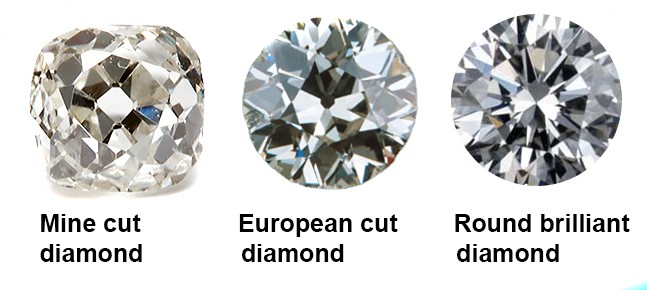
| Old European Cut | Round Brilliant Cut | |
| Table | Small Less than, or equal to 53% of the diameter |
Medium
53% – 58% |
| Culet | Centered culet (no point) | Centered culet Ideally pointed (graded as none, very small or small) |
| Facets | 58 (57 when there is no culet) Often hand-cut therefore less symmetrical and variation in placement and shape |
58 (57 when there is no culet)
Cut to modern, technical specifications therefore less variation |
| Light Performance | Deep proportions; large, face-up facets give a ‘checkerboard’ effect. Designed to give dramatic ‘glow’ in candle light but little scintillation when viewed in modern lighting | Cut to maximize dispersion and fire – fiery white light |
| Color | Cut to maximize color – a warm charm and deep glow | Cut to maximize brilliance – light return and scintillation masking color |
| Crown | Heavy – Greater than, or equal to 40 degrees | 32 – 36 degrees |
There is still a market for the vintage beauty of an old European cut, however the expectation of a ‘sparkling’ diamond sees most buyers opting for a round brilliant. The GIA do offer specifications for an old European cut but due to the variance between each stone they are not issued an official cut grade.
Round Brilliant Cut
The popularity of the round brilliant diamond soared in 1919, when Marcel Tolkowsky’s thesis “Diamond Design: A Study of the Reflection and Refraction of Light in a Diamond” expressed the ideal proportions for a round brilliant diamond in order to maximize light return and fire.
Although Tolkowsky’s original specifications (53% table, 59.3% depth, 34.50 crown angle) have since been altered due to technological advances, his thesis set a standard for round brilliant diamonds which modern cutters have continued to perfect.
The round brilliant cut is defined by its multiple facets that reflect white light giving the diamond its sparkle. A round brilliant diamond has 58 facets.
The table below offers a guideline of the modern cut parameters for a round brilliant diamond. The GIA considers the below factors when grading a round brilliant diamond.
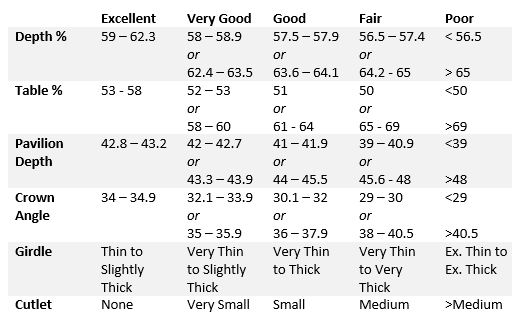
Cut Quality
The cut quality has the greatest impact on the overall aesthetic of a round brilliant diamond. When choosing a round brilliant diamond, the cut should be considered the most important of the 4C’s.
When it comes to determining the true cut quality of a round brilliant, the AGS is the most trusted and renowned gemological laboratory; with a commitment to honest and accurate results, they have extensive technical specifications for the diamonds they grade, in particular, the round brilliant.
They have developed the only scientifically verified system for analyzing the cut quality and light performance of diamonds which built upon their proportion based cut grade. The GIA in comparison have started offering a Cut grading, however this is still extremely limited in comparison to AGS and so, for this reason, we’d only recommend using AGS for this aspect of the process.
The scale below is how the AGS determines the cut grade of a round brilliant diamond.

Another factor which influences the performance of a round brilliant diamond, is whether it has been cut too shallow or too deep.
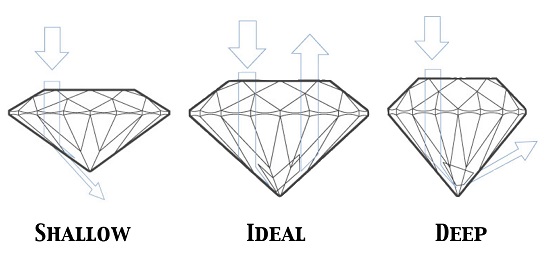
If cut too shallow, the light will hit the pavilion at a low angle; the light then exits through the sides of the diamond without reaching the table. This light leakage greatly diminishes the brilliance and fire of the diamond.
If cut too deep, the light will hit the pavilion at a sharp angle, causing it to be reflected off of another pavilion and out through the bottom of the diamond. Again, the light does not reach the table, and a diamond that has been cut too deep will have a dull appearance.
When a round brilliant is perfectly cut, the light will reach each pavilion and be reflected through the table and crown and ultimately to the eye. The impact of this seemingly effortless light return is one of maximum fire and brilliance, giving the striking sparkle that we expect from a brilliant cut.
However, finding a beautifully cut diamond goes beyond the AGS/GIA scale. A GIA ‘Excellent’ and AGS Ideal cut grades covers a wide spectrum of stones, some of which will offer far greater performance than others. For example an AGS Ideal diamond might not be a hearts and arrows cut.
Some of these collections fail to distinguish themselves from the usual grading systems, however if we take a look at A CUT ABOVE® by Whiteflash, you can see how many other factors are taken into consideration when selecting the diamonds for this prestigious collection.

Diamond Image Idealscope ASET Hearts and Arrows
Above are the images you will see on the Whiteflash website for 1.021ct A CUT ABOVE® Hearts and Arrows Diamond, (from left to right); a high-res image of the diamond, an Ideal-Scope image, and ASET image and a Hearts and Arrows image. The A CUT ABOVE® Diamonds are in my opinion the best quality cut on the market.
Ideal-Scope – A piece of equipment using colored reflectors and magnified scopes to show light performance within a diamond. Black areas indicate light returned at a high angle, red areas indicate the strongest light return to the eye and white and greyish areas show light escaping from the diamond.
ASET (Angular Spectrum Evaluation Tool) – A detailed assessment of light performance and cut quality of the diamond. It is applicable to any shape of diamond and provides a wealth of information regarding the light handling properties of the stone.
Hearts & Arrows – This viewer captures and clearly defines the phenomena found in a round brilliant known as hearts and arrows. A beautifully cut diamond will present the appearance of 8 perfectly symmetrical hearts and 8 perfectly symmetrical arrows. The formation, spacing, and presentation of these hearts and arrows must be precise and perfectly even to be considered a true hearts and arrows diamond.
Having a basic understanding of these images will allow you to compare and contrast the quality of the diamonds you are considering. Whiteflash offer this information as they are confident in the quality of their diamond.
It’s even more important to understand the Four Cs of a brilliant round diamond. Look at the technical data provided by the jewelers and compare them with each of the diamonds you wish to purchase.
Whiteflash, James Allen, and Blue Nile are the three online vendors will provide you with the necessary data to compare.
Round Cut Diamond – Clarity
The GIA clarity grading system categorizes diamonds as follows:
- Flawless (FL)– No inclusions or blemishes are visible to a skilled grader using 10× magnification
- Internally Flawless (IF)– No inclusions and only blemishes are visible to a skilled grader using 10× magnification
- Very, Very Slightly Included (VVS1and VVS2) – Inclusions are difficult for a skilled grader to see under 10× magnification
- Very Slightly Included (VS1and VS2) – Inclusions are minor and range from difficult to somewhat easy for a skilled grader to see under 10x magnification
- Slightly Included (SI1 and SI2) – Inclusions are noticeable to a skilled grader under 10x magnification
- Included (I1, I2, and I3)– Inclusions are obvious under 10× magnification and may affect transparency and brilliance
As with any cut of diamond, the primary factor when choosing a clarity grade for your round brilliant diamond is whether or not the diamond is ‘eye-clean’. An eye-clean diamond may not be graded as flawless but will have no inclusions or blemishes that are visible to the naked eye.
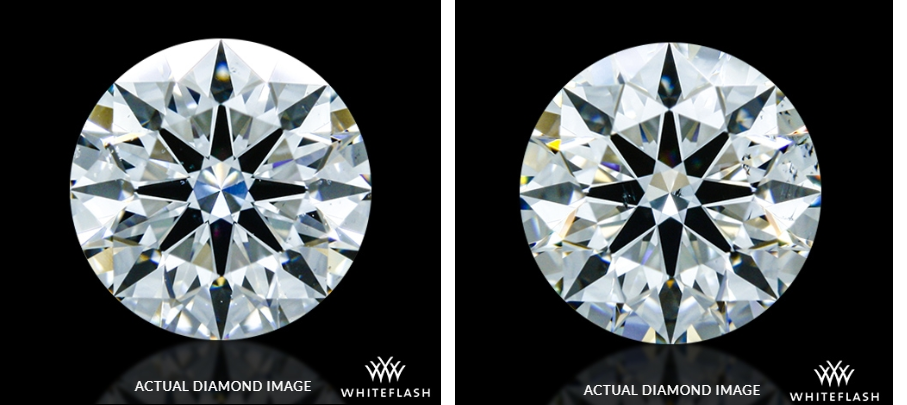
The Whiteflash website allows you to view their diamonds with high-res 360 imaging. They use white lighting to demonstrate the light handling properties of the diamond.
Although this is not an accurate test of something be eye-clean, it shows how two diamonds with the same clarity grading can have very different appearances. Both diamonds are an SI1 clarity grading.
Diamond 1 has no visible inclusions when looking directly into the table. Any inclusions are towards the edges and culet of the diamond, meaning there is minimal superficial impact.
Diamond 2 has a small, dark inclusion in the center of the table. This means that even when the diamond is set, the inclusions cannot be hidden with the setting.
Eye-clean is what you are looking for in order to get the best diamond for the best price, and this is not always easy to identify. Whiteflash will indicate whether or not the diamond is eye-clean. This information is not yet offered by other vendors, making it easier than ever to select a beautiful diamond from the Whiteflash collection.
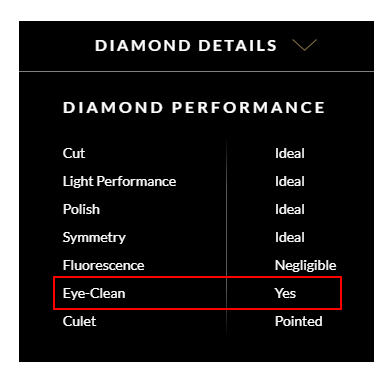
When choosing your diamond and considering clarity, it is best to trust your eyes. You can find an eye-clean SI1 that will appear the same as a VVS1 but at a fraction of the cost. Similarly, you will still find diamonds graded VS2 that have inclusions in obvious places, detracting from the beauty of the stone.
Although eye-clean is what matters for your jewelry, it is always worth taking a closer look at the diamond through a jeweler’s loupe or using high-resolution photography (as seen on the Whiteflash website). This will allow you to identify where the inclusions are and whether they can be concealed in a setting.
It is also a good way to familiarize yourself with the diamond; after all, these inclusions are entirely unique to each stone. Like a birthmark, they are a reminder that the diamond you have chosen was created in the earth. A rare and natural beauty.
Round Cut Diamond – Color
The Old European cut was about emphasizing color, while the modern round brilliant cut is about emphasizing fire and brilliance. The multiple facets of a round brilliant diamond mean they reflect more light and therefore conceal color more effectively than other cuts of diamond.
For this reason, it is sometimes possible to come down on the color grade when selecting a round brilliant diamond, with little impact on the overall appearance. This means if you are playing with a budget, go for a better cut quality and come down on the color grade for the best looking diamond.
A color grading of D, E, or F is considered colorless, while G, H and I are considered near colorless.
Color is often a trade off. Some customers are more color sensitive and some aren’t. Many people won’t see color in H, I and J diamonds for example, however in my expert opinion the majority of people are more color sensitive. If you’re looking to purchase colorless diamonds I would consider the Collection Series from Whiteflash.
Be aware that in a larger the stone, the more obvious any yellow hues will become. Also, if you are looking to set your diamond with side stones, be sure that the side stones are a similar color grade (no more than two grades different). If the side stones are a better color than the central stone they will make it look yellow.
Color is not the most influencing factor in a round brilliant diamond; although these guidelines aim to find the sweet spot between quality and price, there is a little more flexibility when it comes to choosing the color grade of your round brilliant. As always, trust your eye and work within your budget. Priorities cut quality over color.
The Final Word
If you are choosing a round brilliant diamond, and want to know the specifications for the absolute, best of the best, super-ideal cut diamonds, then you must read my review of the A CUT ABOVE® line by Whiteflash. This outlines the specific, stringent parameters that must be met to qualify as an A CUT ABOVE® diamond. I would also take a look at my review on the Astor Collection by Blue Nile.
We covet round cut diamonds for their classic elegance and timeless nature. They can be seamlessly worked into almost any setting or be left to dazzle alone in a simple solitaire. Above all, we yearn for their signature sparkle, fire and brilliance; this appearance is only possible with the best cut quality.

Richard Jenkins, The Diamond Guru
Get free assistance from the Diamond Guru today. You’ll be glad you did!
- Secure the best quality diamond for your budget.
- Don’t pay over the odds for your diamond ring.
- Have peace of mind that you didn’t get ripped off.
Have a Question? Contact us now…

